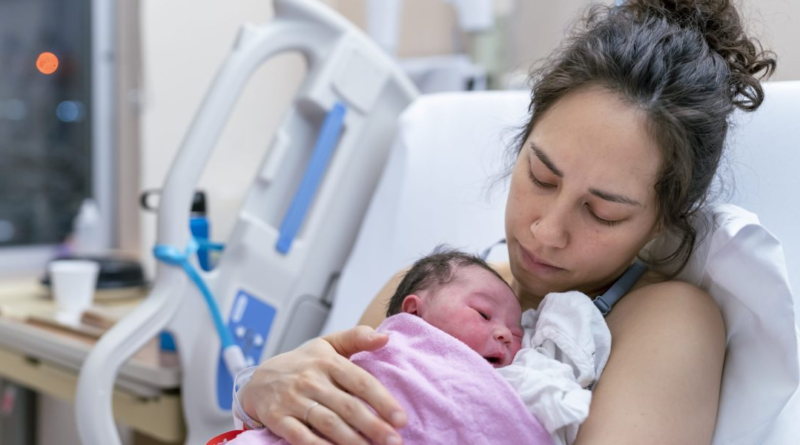Birthing mothers’ near-death experience rates are 100 times higher than maternal mortality—and we don’t even know exactly why
After going through nine arduous rounds of IVF, Michelle and Zach Lee happily became pregnant and were on their baby moon when Michelle started seeing sparkles in her vision, like little silver, iridescent shooting stars.
Around 32 weeks in, Michelle’s seemingly normal pregnancy transformed in a flash. She learned she developed severe preeclampsia, a condition of high blood pressure during pregnancy and a leading cause of maternal mortality and morbidity. Michelle had to deliver within days of first experiencing symptoms. After the delivery, she experienced postpartum hemorrhaging, which nearly proved fatal, and her baby boy spent his first 28 days of life in the NICU because he was born prematurely.
Thankfully, Michelle and her baby have recovered and are now thriving. However, we’ve heard countless stories like Michelle and Zach’s, where symptoms arise for complications like preeclampsia and a seemingly normal pregnancy turns into a crisis in a matter of days or even hours. When a woman is diagnosed with preeclampsia, it’s already at a dangerous stage and delivering the baby prematurely is currently the main intervention to save the lives of both mom and baby.
Considering pregnancy is a stress test on the body that pushes women to their physiological limits, it is shocking how little we know about the biology of pregnancy. Because pregnancy has been under-researched and under-resourced, there’s a limited understanding of how the placenta can influence who develops pregnancy complications, why this happens, and how we can intervene.
While maternal mortality is the most devastating outcome, it’s only the tip of the iceberg. For each death, there are 100 women who come close to dying, which is terrifying and unacceptable in the 21st century. The maternal health crisis is even more devastating for Black women, who are 2.5 times more likely to die from pregnancy complications compared to white women.
However, pregnancy complications don’t discriminate. What we’ve seen is that even access to care, good health, and wealth are not enough to avoid pregnancy complications.
All hands on deck to galvanize a new era of pregnancy health
Currently, there is no effective way to predict who will develop life-threatening complications in pregnancy.
For example, preeclampsia was officially recognized as a complication threatening pregnant women more than 100 years ago. However, in over a century, there’s been a failure to uncover the why behind who’s most at-risk.
Importantly, pregnancy health is also lifetime health. For example, women who develop preeclampsia are at increased risk of chronic high blood pressure, stroke, heart disease and organ failure. Additionally, pregnancy complications can also impact the health of the child throughout their lifetime, such as higher risk of obesity and diabetes.
The pregnancy journey is a profound, moving experience and one of the most important events in the lives of those who choose to become parents. While women intimately experience the pregnancy journey—enduring both the physical and mental impact—it’s easy for the non-birthing parent, especially men, to not register how grueling the journey can be. However, the speed of progress and number of breakthroughs would greatly increase if more men took an active role in trying to reverse the tide of the maternal health crisis.
The opportunity for a paradigm shift from reactive to proactive care
Beyond the emotional and physical toll, pregnancy complications also represent a significant financial drain: A report found the costs associated with maternal morbidity in the healthcare system and society overall were more than $30 billion in 2019.
Innovation is finally emerging to objectively predict who’s at the highest risk of developing pregnancy complications. We’re finally at the threshold of shifting pregnancy care from reactive to proactive care.
With screening tests, we can start identifying pregnant women at risk for complications and intervene early. This will spare families untold distress while also significantly reducing healthcare costs. Additionally, there are tremendous opportunities for value creation when investing in breakthroughs targeting pregnancy care as solutions are desperately needed to solve the maternal health crisis.
Women’s healthcare is far from a niche. Investments here create a ripple effect, positively impacting families, healthcare systems, economic productivity and society. In 2024, it is imperative we catalyze progress on pregnancy health with robust funding, bold research, and evidence-based, groundbreaking solutions.
This is an urgent call for action—to the executives, investors, researchers, scientists, founders, clinicians, and more. We need more support to create a world where every pregnancy is as healthy and as safe as possible. This is a mission everyone can get on board with because pregnancy health is family health.
Together, we can initiate a transformative shift the field so desperately needs. Our collective power can make lasting change so stories like Michelle and Zach’s are few and far between.
Holly Maloney is managing director of General Catalyst. Maneesh Jain is CEO and co-founder of Mirvie.
More must-read commentary published by Fortune:
The opinions expressed in Fortune.com commentary pieces are solely the views of their authors and do not necessarily reflect the opinions and beliefs of Fortune.




